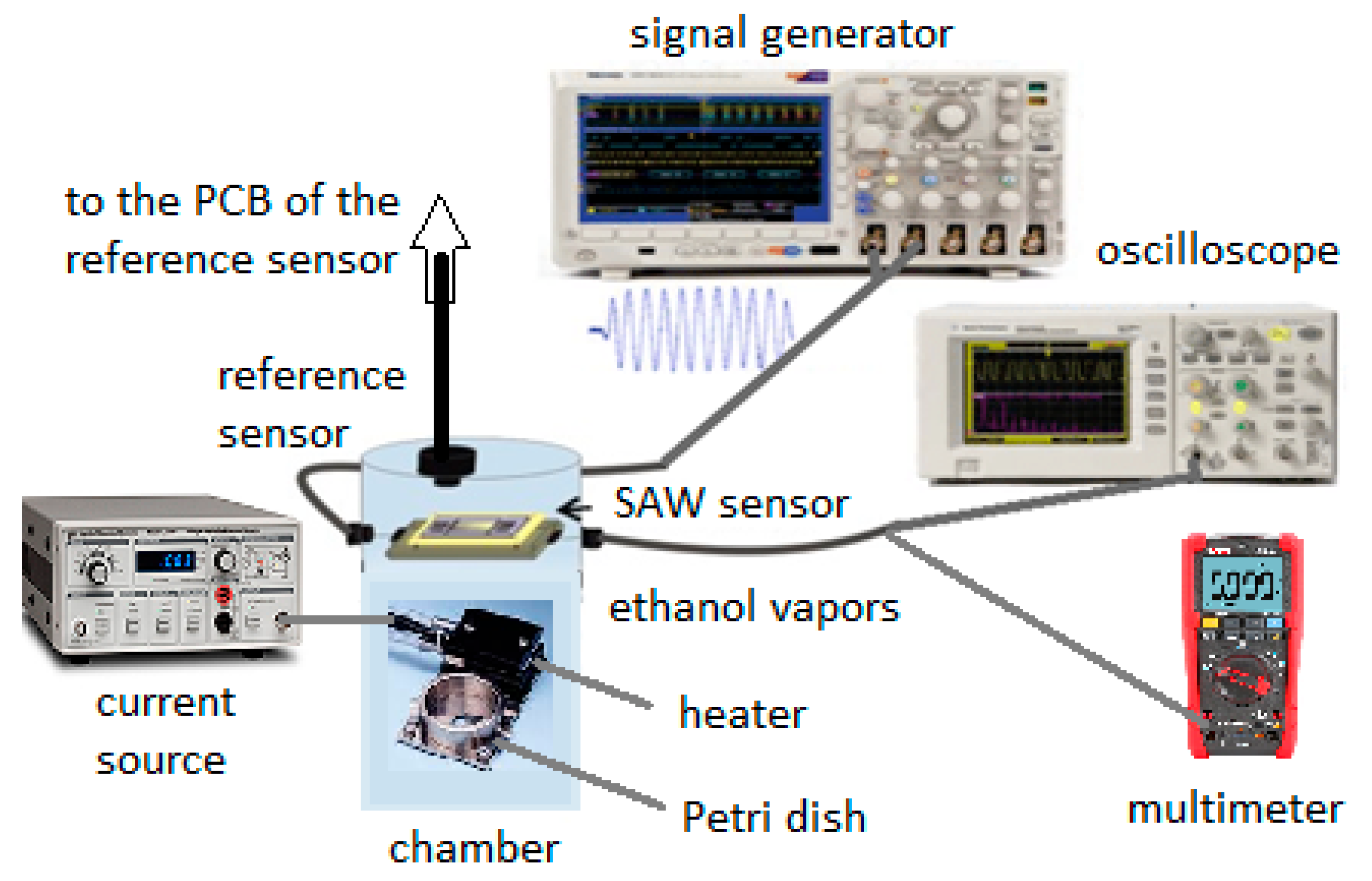Gas-Sensing Properties of a Carbyne-Enriched Nanocoating Deposited onto Surface Acoustic Wave Composite Substrates with Various Electrode Topologies
Abstract
:1. Introduction
2. Materials and Methods
3. Results and Discussion
4. Conclusions
Author Contributions
Funding
Institutional Review Board Statement
Informed Consent Statement
Data Availability Statement
Conflicts of Interest
References
- Flood, P.; Babaev, V.; Khvostov, V.; Novikov, N.; Guseva, M. Carbon Material with a Highly Ordered Linear-Chain Structure. In Polyynes Synthesis, Properties and Applications; Cataldo, F., Ed.; Taylor & Francis Group: Didcot, UK, 2005; pp. 219–252. [Google Scholar] [CrossRef]
- Aleksandrov, A.F.; Guseva, M.B.; Savchenko, N.V.; Streletskii, O.A.; Khvostov, V.V. The Film of Two-Dimensionally Ordered Linear-Chain Carbon and Method of Its Production. Russian Patent Application No. 2564288, 10 May 2015. [Google Scholar]
- Graphene-Info Updates All Its Graphene Market Report. Available online: https://www.graphene-info.com/graphene-info-updates-all-its-graphene-market-report-6 (accessed on 1 March 2022).
- Akinwande, D.; Huyghebaert, C.; Wang, C.-H.; Serna, M.I.; Goossens, S.; Li, L.-J.; Wong, H.-S.P.; Koppens, F.H.L. Graphene and two-dimensional materials for silicon technology. Nature 2019, 573, 507–518. [Google Scholar] [CrossRef] [PubMed]
- Grogan, C.; Amarandei, G.; Lawless, S.; Pedreschi, F.; Lyng, F.; Benito-Lopez, F.; Raiteri, R.; Florea, L. Silicon Microcantilever Sensors to Detect the Reversible Conformational Change of a Molecular Switch, Spiropyan. Sensors 2020, 20, 854. [Google Scholar] [CrossRef] [PubMed] [Green Version]
- Boom, B.A.; Bertolini, A.; Hennes, E.; van den Brand, J.F.J. Gas Damping in Capacitive MEMS Transducers in the Free Molecular Flow Regime. Sensors 2021, 21, 2566. [Google Scholar] [CrossRef] [PubMed]
- Yao, X.; Zhang, Y.; Cui, Y. A Microfabricated Transparent Capacitor for Sensing Ethanol. J. Microelectromechanical Syst. 2019, 28, 164–169. [Google Scholar] [CrossRef]
- Yang, M.Z.; Dai, C.L. A Capacitive Ammonia Sensor Using the Commercial 0.18 μm CMOS Process. In Advanced Materials Research; Trans Tech Publications Ltd.: Kapellweg, Switzerland, 2015. [Google Scholar]
- Teradal, N.L.; Marx, S.; Morag, A.; Jelinek, R. Porous graphene oxide chemi-capacitor vapor sensor array. J. Mater. Chem. C 2017, 5, 1128–1135. [Google Scholar] [CrossRef]
- Mohammed, Z.; Elfadel, I.A.M.; Rasras, M. Monolithic Multi Degree of Freedom (MDoF) Capacitive MEMS Accelerometers. Micromachines 2018, 9, 602. [Google Scholar] [CrossRef] [PubMed] [Green Version]
- Mouro, J.; Pinto, R.; Paoletti, P.; Tiribilli, B. Microcantilever: Dynamical Response for Mass Sensing and Fluid Characterization. Sensors 2021, 21, 115. [Google Scholar] [CrossRef] [PubMed]
- Bouchaala, A.; Nayfeh, A.H.; Younis, M.I. Frequency Shifts of Micro and Nano Cantilever Beam Resonators Due to Added Masses. J. Dyn. Sys. Meas. Control. 2016, 138, 091002. [Google Scholar] [CrossRef]
- Lu, X.; Cui, M.; Yi, Q.; Kamrani, A. Detection of mutant genes with different types of biosensor methods. TrAC Trends Anal. Chem. 2020, 126, 115860. [Google Scholar] [CrossRef]
- Yeo, L.Y.; Friend, J.R. Surface Acoustic Wave Microfluidics. Annu. Rev. Fluid Mech. 2014, 46, 379–406. [Google Scholar] [CrossRef] [Green Version]
- Chen, Q.; Wang, D.; Cai, G.; Xiong, Y.; Li, Y.; Wang, M.; Huo, H.; Lin, J. Fast and sensitive detection of foodborne pathogen using electrochemical impedance analysis, urease catalysis and microfluidics. Biosens. Bioelectron. 2016, 86, 770–776. [Google Scholar] [CrossRef] [PubMed]
- Agostini, M.; Greco, G.; Cecchini, M. Full-SAW Microfluidics-Based Lab-on-a-Chip for Biosensing. IEEE Access 2019, 7, 70901–70909. [Google Scholar] [CrossRef]
- Chen, F.; Kong, L.; Song, W.; Jiang, C.; Tian, S.; Yu, F.; Qin, L.; Wang, C.; Zhao, X. The electromechanical features of LiNbO3 crystal for potential high temperature piezoelectric applications. J. Mater. 2019, 5, 73–80. [Google Scholar] [CrossRef]
- Streletskiy, O.A.; Zavidovskiy, I.A.; Nischak, O.Y.; Pavlikov, A.V. Multiphonon replicas in Raman spectra and conductivity properties of carbon films with different concentrations of sp1-bonds. Thin Solid Film. 2019, 671, 31–35. [Google Scholar] [CrossRef]
- Buntov, E.A.; Zatsepin, A.F.; Guseva, M.B.; Ponosov, Y.S. 2D-ordered kinked carbyne chains: DFT modeling and Raman characterization. Carbon 2017, 117, 271–278. [Google Scholar] [CrossRef]
- Streletskiy, O.A.; Zavidovskiy, I.A.; Nischak, O.Y.; Dvoryak, S.V. Electrical conductivity and structural properties of a-C:N films deposited by ion-assisted pulse-arc sputtering. Thin Solid Film. 2020, 701, 137948. [Google Scholar] [CrossRef]
- Boqizoda, D.; Zatsepin, A.; Buntov, E.; Slesarev, A.; Osheva, D.; Kitayeva, T. Macroscopic behavior and microscopic factors of electron emission from chained nanocarbon coatings. C 2019, 5, 55. [Google Scholar] [CrossRef] [Green Version]
- Ballantine, D.S.; White, R.; Martin, S.; Ricco, J.; Zellers, E.; Frye, G.; Wohltjen, H. Acoustic Wave Sensors Theory, Design and Physico-Chemical Applications: A Volume in Applications of Modern Acoustics; Elsevier Inc.: Amsterdam, The Netherlands, 1997. [Google Scholar]








| Parameter/ Device No. | Geometry and Sensing Film Thickness, nm | Sensitivity, µV/ppm | Dynamic Range, ppm | Linearity, % | Response Time, s | Recovery Time, s |
|---|---|---|---|---|---|---|
| Device 1 | Coarse combs/280 nm | 227 | 184 | 0.94 | 28 | 20.1 |
| Device 2 | Fine combs/280 nm | 221 | 330 | 3.9 | 20 | 14.1 |
| Device 3 | Fine combs/140 nm | 80 | 428 | 0.97 | 31 | 15 |
Publisher’s Note: MDPI stays neutral with regard to jurisdictional claims in published maps and institutional affiliations. |
© 2022 by the authors. Licensee MDPI, Basel, Switzerland. This article is an open access article distributed under the terms and conditions of the Creative Commons Attribution (CC BY) license (https://creativecommons.org/licenses/by/4.0/).
Share and Cite
Aleksandrova, M.; Kolev, G.; Brigadin, A.; Lukin, A. Gas-Sensing Properties of a Carbyne-Enriched Nanocoating Deposited onto Surface Acoustic Wave Composite Substrates with Various Electrode Topologies. Crystals 2022, 12, 501. https://doi.org/10.3390/cryst12040501
Aleksandrova M, Kolev G, Brigadin A, Lukin A. Gas-Sensing Properties of a Carbyne-Enriched Nanocoating Deposited onto Surface Acoustic Wave Composite Substrates with Various Electrode Topologies. Crystals. 2022; 12(4):501. https://doi.org/10.3390/cryst12040501
Chicago/Turabian StyleAleksandrova, Mariya, Georgi Kolev, Andrey Brigadin, and Alexander Lukin. 2022. "Gas-Sensing Properties of a Carbyne-Enriched Nanocoating Deposited onto Surface Acoustic Wave Composite Substrates with Various Electrode Topologies" Crystals 12, no. 4: 501. https://doi.org/10.3390/cryst12040501
APA StyleAleksandrova, M., Kolev, G., Brigadin, A., & Lukin, A. (2022). Gas-Sensing Properties of a Carbyne-Enriched Nanocoating Deposited onto Surface Acoustic Wave Composite Substrates with Various Electrode Topologies. Crystals, 12(4), 501. https://doi.org/10.3390/cryst12040501








